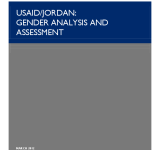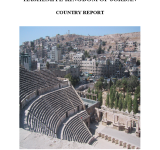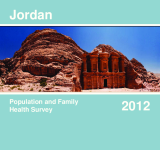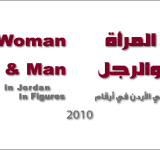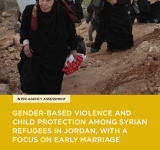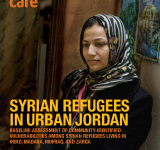The report presents an up-to-date analysis of gender disparities in Jordan to inform development assistance programs by the USAID for the 2013-2017 strategic plan. The assessment report is prepared by the Global Health Technical Assistance Project;; funded by USAID Jordan and therefore;; it is based on a literature review and field work of the 21 focus group discussions held in Amman;; Irbid;; Tafileh and Zarqa. The report establishes that Jordan has begun to transition to a knowledge-based economy with the national advantage as its people. It also points out that despite the investments that have helped address gender equality issues;; Jordan continues to bear low female participation in the labor markets;; gender stereotypes about the role of females and males and conservative cultural norms. The report includes a sector-by-sector analysis;; recommendations;; gender review and an illustrative implementation plan. It concludes with key recommendations on the wide breadth of the USAID Jordan portfolio with a key emphasis on gender issues.
household
The report was published from the World Health Organization/ United Nations Children’s Fund (WHO/UNICEF)’s pilot project to test a method for the rapid assessment of the quality of drinking-water in six countries;; including Jordan;; China;; Ethiopia;; Nicaragua;; Nigeria and Tajikistan. This assessment report aims to develop a tool that would support WHO/UNICEF’s joint program in strengthening the monitoring efforts of the global access to safe drinking water. The analysis of the report is based on the water samples and statistical data that were collected from 1600 drinking water supply sites in 67 clusters. The report finds that drinking water quality is generally high in the distribution network of Jordan and national standards for bacteria complies with the WHO guideline values. It also identifies the sanitary risk factors for Jordanian water supplies including the presence of sewer lines;; old pipes and failure to properly maintain household storage tanks.
يلخص هذا التقرير نتائج مسح السكان والصحة الأسرية في الأردن عام 2012 الذي أجرته دائرة الاحصاءات العامة. ولقد نفذ المسح ضمن برنامج المسوح الديموغرافية والصحية الذي تم تصميمه من أجل جمع البيانات عن الانجاب وتنظيم والأسرة وصحة الأمهات والأطفال. ولقد قدمت مؤسسة ICF الدولية المساعدة الفنية لهذا المشروع من خلال برنامج المسوح الديموغرافية والصحية.
يوجز هذا التقرير أوضاع المرأة الأردنية من خلال جداول احصائية مصنفة حسب النوع الاجتماعي;; ويرصد بشكل مختصر أبرز المنجزات التي تم تحقيقها;; وكما يشير إلى الفجوات الواجب معالجتها.
The report is based on the KAP household baseline survey;; which measures the current awareness of methods of water and energy conservations to determine how the Jordanians currently dispose of their household waste and how serious they believe the threat of global warming to be in Jordan. The household baseline survey on the use of water;; energy;; and the management of solid household waste has been designed based on the Knowledge;; Attitude and Practice (KAP) model;; and it aims to serve as a prelude to education and changing public behavior in the water and energy sectors in Jordan;; and to supply specific initiatives in the environment;; in particular in regard to the management of solid household waste. The research is based on a qualitative research;; a questionnaire and semi-structured interviews. The report concludes with the main findings that the most trusted sources of information on water conservation were the Ministry of Water and Irrigation;; and the Jordan Water Company. The survey finds that the respondents believe that the water shortage can be overcome with the water authorities' leadership including their engagement in grand projects.
يتضمن هذا التقرير تحليلاً موسعاً ومتكاملاً لمؤشرات الفقر بالاستناد إلى بيانات نفقات ودخل الأسرة لعام 2010 والذي بلغ حجم عينته 13866 أسرة ممثلة لكافة مناطق المملكة;; الذي نفذته دائرة الاحصاءات العامة على أربع جولات ميدانية استمرت لمدة عام وانتهت عام 2011. وجاء هذا التقرير ليتناول قياس مؤشرات الفقر باستخدام منهجية السعرات الحرارية المعتمدة من قبل البنك الدولي ومقارنتها عبر الزمن بالأسعار الثابتة. ويتضمن التقرير ثلاثة فصول: الأول يتناول منهجية قياس الفقر على مستوى المملكة والمحافظات وتحديد الأقضية الأشد فقراً;; أما الفصل الثاني فيتناول الجانب التحليلي لمسح نفقات ودخل الأسرة على مستوى الخمسينات;; وكما تناول هذا الفصل تحليل الجوانب الاجتماعية للأسرة الأردنية. فيما يتناول الفصل الثالث أثر التحويلات النقدية والتدخلات الحكومية وانعكاسة على ظاهرة الفقر والحد منها في عام 2010
The report aims to address the particular needs and cultural dynamics of Syrian refugees residing in Jordan;; especially with regards gender-based violence and child protection issues. It presents a comprehensive range of perspectives from urban Syrian refugees and local Jordanian decision makers in government;; community-based organizations and the religious and education sectors. The assessment of this report is based on data collected through three methodologies including questionnaire survey to refugees outside the Za’atari refugee camp;; focus group discussions in regions across Jordan and in-depth interviews. Key findings of the report are 1. The rates of early marriage are high;; 2. A significant percentage of children contribute to the household’s income and 3. Restrictions on women and girls’ mobility constrain their participation in social and economic activities and access to basic services. The report recommends measures to prevent acts of sexual exploitation and abuse and ensure the needs of the most vulnerable members of the Syrian refugee population in the cities.
This report is a baseline assessment of community-identified vulnerabilities among Syrian refugees living in Amman;; Irbid;; Madaba;; Mufraq;; and Zarqa. The purpose of this report is to identify urban Syrian refugees’ current coping mechanisms and any gaps in services available to Syrian refugees in Jordan. The research methodology is both qualitative and participatory in design;; drawing from the UNHCR tool for Participatory Assessment in Operations. This report presents only the data from household interviews;; baseline assessment;; and the follow-up focus groups conducted with community members. The number of households surveyed was 240;; with a total number of 1;;476 household members and 89 focus group participants representing 534 household members. The report proposed general recommendations and interventions to deal with the main highlighted challenges (cash assistance;; strengthening community links;; vocational training;; physical activities ...etc).
